The Kathryn Posin Dance Company performs at 92Y.
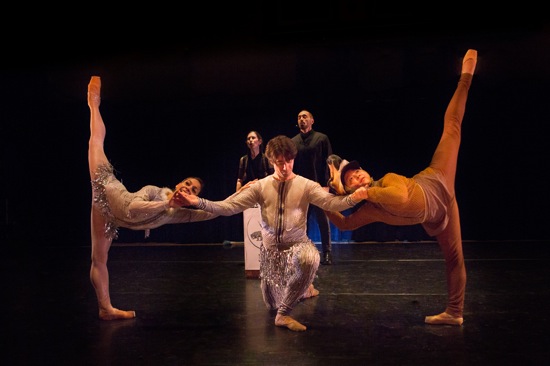
Kathryn Posin’s Climate Control. Cristian Laverde König supports Yumelia Garcia (L) and Kara Chan. At back: Meredith Monk and Theo Bleckmann. Photo: Yi-Chun Wu
Think about Swan Lake and numerous 19th-century fairytale ballets—both tragedies and those with happy endings. Did/does anyone question why an “oriental” houri wears pointe shoes or why the vengeful ghost of a jilted bride dances in a moonlit forest with a cohort of similarly affected others? Mostly we accept the story and how it is told. This, after all, is Balletland, not the Bavaria or Transylvania we’re told to believe it is.
I could almost imagine seeing choreographer Kathryn Posin’s Climate Control at the Opéra Comique in Paris, ca. 1880, were it not for its title, message, and props. Instead, Climate Control premiered in February 2016, as the opening event in the annual Harkness Dance Festival at what’s now called 92Y (trendier and far shorter than “the 92nd Street YM-YWHA”). Posin’s ballet is a stylistic amalgam. Watching it, I have trouble deciding when she has her tongue in her cheek and when she’s wearing her heart on her sleeve. Its title proclaims her environmental concerns, as does the partial Robert Frost quotation included in the program: “Some say the world will end in fire, some say in ice.” Some of the moves are balletic (with women on pointe); some are pantomimic or more “natural.”
The seven exemplary dancers portray two ethnic groups from radically diverse climes, as A. Christina Giannini’s extraordinary costumes make clear. McKenna Birmingham and Daniel Baker are dressed as fantasy Eskimos, fur-trimmed hoods and all. Megan Dickinson and Ryan Redmond wear grass skirts and wreaths on their heads, except that the “grass” is silver tinsel (which sheds and needs sweeping up between scenes), and the wreaths don’t bring green leaves to mind. The principal couple emphasizes the Romeo-and-Juliet angle; Yumelia Garcia is garbed in leather and fur, Cristian Laverde König wears a silver skirt. Kara Chan appears periodically, disguised by a deer head. Charmingly serious and naïve about their opposite numbers’ culture, these characters also bring to mind a fantasy scene in a musical or a school pageant by fearsomely bright children.
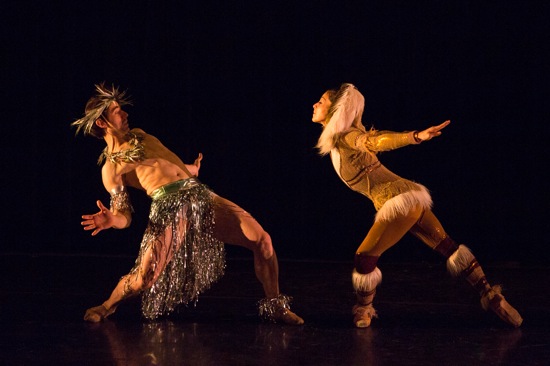
Cristian Laverde König and Yumelia Garcia meet cute in Kathryn Posin’s Climate Control. Photo: Yi-Chun Wu
The Kathryn Posin Dance Company’s two nights at 92Y were supposed to open Kaufmann Concert Hall, which has been closed for some time, but were moved to beautiful little Buttenwieser Hall, where some audience members sat on the small stage, others on chairs placed on risers, and the remainder on low benches. The atmosphere was intimate, and the friendliness established by Posin’s humorous introduction was further enhanced by the bar in the lobby, where people could gather during the two intermissions.
(I should say right off that Posin and I go way back, when we were both involved in the original Dance Theater Workshop of the 1960s and performed in Jeff Duncan’s company. She went on to choreograph works for numerous dance companies worldwide, modifying her own modern-dance background as she moved toward ballet. )
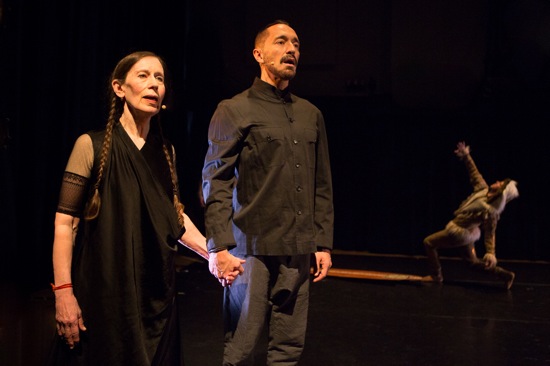
Meredith Monk and Theo Bleckmann singing Monk’s Facing North in Climate Control. Photo: Yi-Chun Wu
The musical element of Climate Control is startling. Posin has set the work to five selections from Meredith Monk’s marvelous Facing North (1990, recorded by ECM in 1992), and Theo Bleckmann and Monk herself are there to sing it. They also reconstruct some of the images that Monk and her original partner, Robert Een, created during the original, almost hour-long performance. They begin facing each other, framing the action, and end the same way—walking toward each other, increasing the speed of their vocalized dialogue, and slowing it down as they retreat (in the final virtuosic “Hocket,” they alternate singing short parts of the composition at each other; it’s like a conversation in which people finish their partner’s sentences and without any pauses). They sing “Keeping Warm” off to one side, warming their hands over the imaginary fire ignited by Bill Schaffner’s intrepid lighting. And in “Arctic Bar,” they sing behind a box so labeled, while the dancers in front of them share drinks and copy the singers’ hand patterns. I find it difficult to take my eyes off Monk and Bleckmann, whether they’re creating a pattern of syllables beginning with the letter “h,” panting rhythmically, or engaging in any of the other remarkable wordless vocalizing—sometimes, witty, sometimes poignant, and much beside— that characterizes Monk’s work.
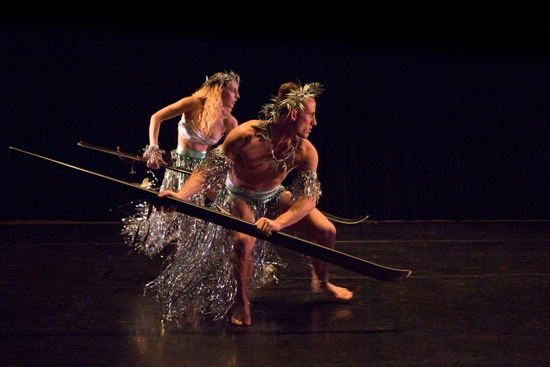
Tropical islanders cope with skis in Kathryn Posin’s Climate Control: Ryan Redmond and Megan Dickinson. Photo: Yi-Chun Wu
The dancers from a warm zone and those from a cold one find themselves coming closer to one another both literally and figuratively. Birmingham and Baker are not sure what to do with the finely decorated surfboard that they come across (props by Todd Strong), but what with the glaciers melting (and thanks to the wheels on the board), they figure it out. Dickinson and Redmond are only initially at a loss to know what to do with skis. Garcia and Laverde König cautiously find what they have in common or can learn; in the end, he supports her in a pirouette and hoists her overhead in a one-armed lift, as if ballet could stand for the lingua franca that might save the environment (or emphasize its collapse).
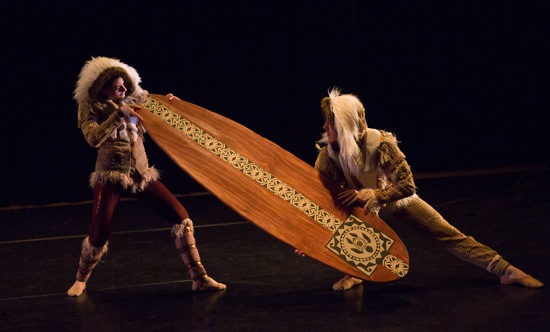
What to do with a surfboard in the Arctic? McKenna Birmingham and Daniel Baker. Photo: Yi-Chun Wu
And as Climate Control progresses, members of the two ethnic groups alter their costumes to become more alike. Actually, maybe since global warming is the major issue, the people from the north lose their hoods and fur-trimmed jackets and develop embryonic “grass” skirts. Is all this entertaining? Very much so. Is it puzzling? You bet.
Posin’s 92Y program began with Century Rolls (first shown in 2014 on a program of hers called “Voices of Bulgaria and America”). Six of the excellent dancers in Climate Control perform it, with the addition of Adrianna de Svastich and (at the second performance) of New York City Ballet’s superb principal dancer Amar Ramasar—performing the role that Laverde König danced at the first performance and thrilling the spectators. The score by John Adams, also titled Century Rolls, refers to those old-time piano rolls that could make your player piano into a music box. It’s a piano concerto, scored for winds, brass, and percussion.
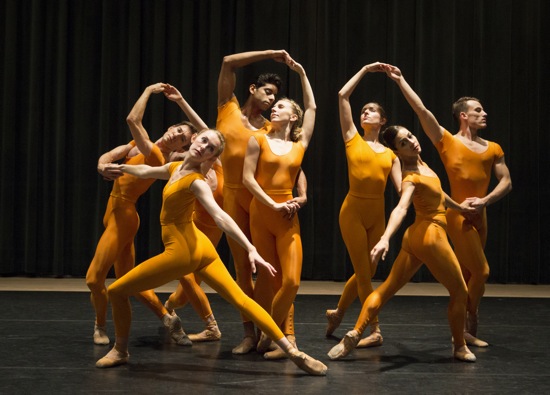
Kathryn Posin’s Century Rolls (2014 cast). Center: Megan Dickinson and Amar Ramasar. The others are Miriam Earnest, Yumelia Garcia, Amber Neff, Ryan Redmond, Adrianna de Svastich and Phillip Velinov. Photo: Julie Lemberger
The music’s underlying repeated patterns drive the choreography along, although at times it sounds almost too rich and heavy for Posin’s non-stop choreography. She has a gift for spatial patterns—rapidly making and unmaking duets in order to form trios, having a soloist vault into a design and disrupt it, deploying two women, and bringing all the dancers together in a handsomely woven cluster. Despite the formalism and the classical steps, the small space and the closeness of the performers make you see this “dancey” dance almost as if it were a scene outside a bar on a summer night.
One curious stylistic trait. Every now and then, one of these elegantly trained dancers will wilt, become knock-kneed, and turn in his/her feet, then continue the dancing as if this had been no more momentous than a burp. Once Ramasar, who enters with a phenomenal leap, exits hunched and jerking, temporarily crippled; you worry for him. Once, when all have gathered in a tableau, two women reach up behind them and place a hand on either of Ramasar’s cheeks. What is that about? Did Posin hear something in the music that passed me by? Or is this her inner modern dancer breaking its way out of her ballet mode until she can beat it back into place with a well-timed arabesque?
There’s nothing balletic about Posin’s 1975 Wave (reconstructed by Lance Westergard, who performed in the original cast). To an electronic music score by Laurie Spiegel, seven clustering dancers, wearing pale blue unitards, travel slowly along a diagonal path, like a wave gathering force, even though independent elements seethe up within it—one dancer falling and rolling, another rising, one stepping over, another slipping under. Unlike Doris Humphrey’s pioneering 1928 Water Study, Wave doesn’t seek to depict a whole mass of water cresting and rolling up the shore or a tide retreating. Instead, some of the movements convey struggle in unusual ways. The dancers often curl their arms into a hoop, but instead of touching their fingertips together, they tap one fist against the other. They also clasp their hands behind their backs—an awkward position to maintain as they bend over, as they turn, as they drop to the floor.
So the dance could be seen as an onerous voyage by a band of travelers. When each of two men braces a woman who’s standing on his thighs, those women gaze ardently into the distance, as if hoping to sight a safe harbor. In organizing the program to end with her beginnings, Posin may have intended to remind us that the oceans were once cleaner, and we were all more optimistic.

Lovely writing, comme toujours, and I wish I could have been there for all of it, but especially Meredith Monk.